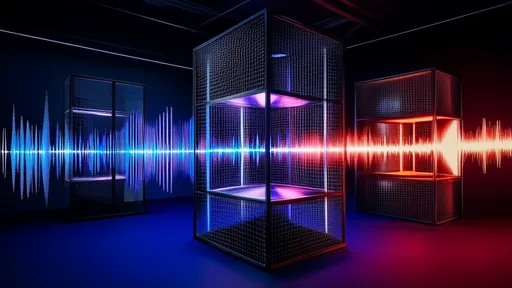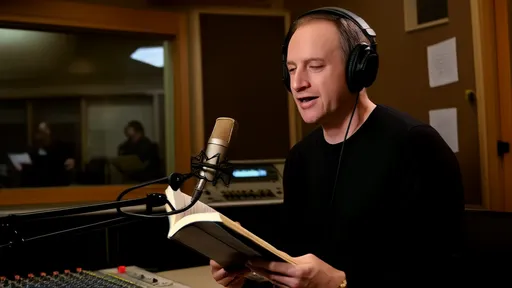The world of audiobook production is a fascinating intersection of technical precision and artistic interpretation. While listeners often focus on the final product—the seamless narration that brings stories to life—few realize the intricate process behind creating these auditory experiences. At the heart of this process lies the voice actor, whose role extends far beyond simple reading. Their work constitutes a true second creation, transforming written words into living, breathing performances.
Voice actors in audiobook production are more than just narrators; they are interpreters, emotional conduits, and storytellers. Unlike stage or screen actors who rely on physical presence and facial expressions, voice actors must convey every nuance solely through their vocal instrument. This demands an extraordinary level of skill—the ability to create distinct character voices, maintain consistent accents across hundreds of pages, and sustain emotional authenticity throughout lengthy recording sessions. The best voice actors make this invisible labor seem effortless, but the craft involves years of training and refinement.
The preparation phase before recording begins is where much of the magic happens. Professional audiobook narrators typically spend hours—sometimes days—analyzing the text before ever setting foot in the studio. They mark up manuscripts with detailed notes about character motivations, emotional arcs, and pacing. Some create elaborate character backstories that never appear in the text but inform their vocal choices. This deep textual analysis allows them to deliver performances that feel organic rather than simply recited. For fiction works, they might develop unique vocal signatures for each character, ensuring listeners can instantly distinguish between them without visual cues.
Technical challenges abound in the recording studio environment. Unlike other voiceover work, audiobook narration requires marathon sessions of sustained vocal performance. Maintaining vocal health becomes paramount, with actors employing various techniques—from steam inhalation to specific dietary habits—to preserve their instrument. The physicality of performance also plays a crucial role; many narrators stand or use specific postures to access their full vocal range, while facial expressions and gestures often accompany their delivery even though listeners never see them. Studio etiquette is equally important, with narrators needing to maintain consistent microphone positioning and control extraneous noises like stomach growls or page turns.
Direction and collaboration form another critical component of the process. While some narrators work solo, many benefit from the guidance of directors or authors who provide insight into character interpretations or textual nuances. This collaborative dynamic can significantly shape the final product. In some cases, authors participate directly in recording sessions, offering real-time feedback that helps the narrator align their performance with the writer's vision. For translations or classic works, research into historical pronunciation or cultural context becomes part of the preparation, ensuring authenticity in the vocal performance.
The emotional labor involved in audiobook narration is frequently underestimated. Voice actors must repeatedly tap into deep emotional states—sometimes performing traumatic scenes or intense emotional exchanges multiple times to achieve the perfect take. Unlike film sets where emotional scenes might be shot once or twice, audiobook narrators may need to recreate that intensity dozens of times across different takes. This emotional rollercoaster requires not only technical skill but also psychological resilience. Many develop personal techniques to quickly shift between emotional states or decompress after particularly challenging material.
Technology has transformed aspects of audiobook production, but the core artistry remains human. While some publishers experiment with AI narration for certain genres, the subtlety of human-performed audiobooks—with all their imperfections and spontaneous moments of inspiration—continues to set the standard. Listeners respond to the barely perceptible intake of breath before an emotional revelation, the subtle shift in timbre when a character realizes something profound, or the authentic fatigue in a narrator's voice during a character's exhausted moments. These are the elements that make audiobooks feel alive, and they all stem from the voice actor's interpretive choices.
The business side of audiobook narration presents its own challenges. The field has become increasingly competitive, with actors often needing to audition for roles or maintain relationships with multiple publishing houses. Royalty share arrangements, where narrators earn percentages of sales rather than flat fees, have become more common—creating both financial risks and potential rewards. Many successful audiobook narrators develop specialties in particular genres, from romance to thriller to nonfiction, cultivating recognizable vocal brands within those categories. Building this reputation takes years and requires continuous skill development as audience expectations and industry standards evolve.
For listeners, the best audiobook performances feel inevitable—as though no other interpretation of the text could possibly exist. This illusion of effortlessness represents the pinnacle of the voice actor's craft. When listeners forget they're hearing a performance and become fully immersed in the story, that's when the narrator's second creation has succeeded. It's a delicate alchemy of technical skill, emotional intelligence, and creative interpretation that transforms ink on paper into a vivid auditory experience. The next time you lose yourself in an audiobook, take a moment to appreciate the invisible artistry making that magic happen—the countless decisions, preparations, and moments of inspiration that constitute true vocal storytelling.

By /Jul 9, 2025

By /Jul 9, 2025

By /Jul 9, 2025

By /Jul 9, 2025

By /Jul 9, 2025

By /Jul 9, 2025

By /Jul 9, 2025

By /Jul 9, 2025

By /Jul 9, 2025

By /Jul 9, 2025

By /Jul 9, 2025

By /Jul 9, 2025

By /Jul 9, 2025

By /Jul 9, 2025

By /Jul 9, 2025

By /Jul 9, 2025

By /Jul 9, 2025

By /Jul 9, 2025